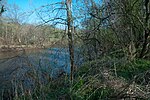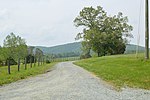Monticello AVA
Monticello is an American Viticultural Area (AVA) located in the central Piedmont region of the Commonwealth of Virginia. It was established by the Bureau of Alcohol, Tobacco and Firearms (ATF) on February 22, 1984 after six wine grape growers in the Charlottesville area petitioned the ATF to designate a viticultural area to be known as “Monticello.” The name "Monticello" is known nationally and locally as the historic home of Thomas Jefferson, located near the center of the area. Monticello AVA includes most of Albemarle, Fluvanna, Greene, Orange, and Nelson counties. The area is nestled along the eastern slopes of the Blue Ridge Mountains and encompasses the small ridge known as the Southwest Mountains. There are approximately 30 varieties of grapes grown in the Monticello AVA. However, the most notable grapes grown in the area include Cabernet Franc, Chardonnay and Viognier. The hardiness zone is 7a except in some higher vineyards which are 6b. In 2019, the Tax and Trade Bureau (TTB) granted a petition to expand the AVA by approximately 106,240 acres (166 sq mi) into Fluvanna County.
Excerpt from the Wikipedia article Monticello AVA (License: CC BY-SA 3.0, Authors).Monticello AVA
Simeon Court,
Geographical coordinates (GPS) Address Nearby Places Show on map
Geographical coordinates (GPS)
| Latitude | Longitude |
|---|---|
| N 38 ° | E -78.416666666667 ° |
Address
Simeon Court 2407
22902
Virginia, United States
Open on Google Maps





